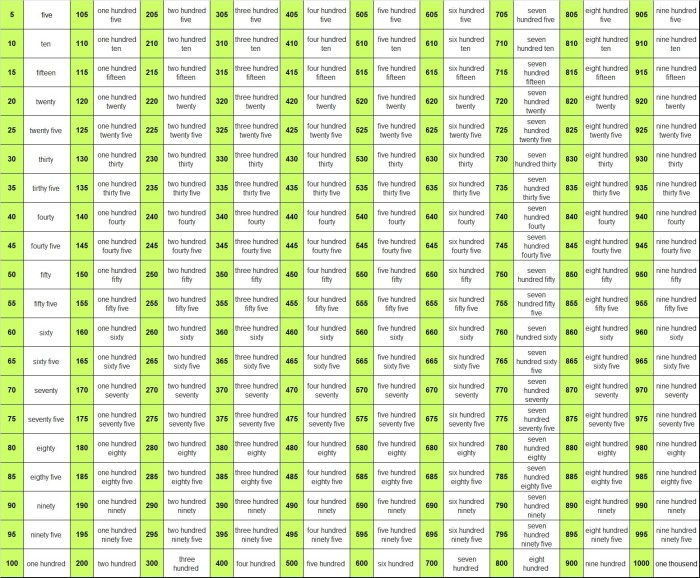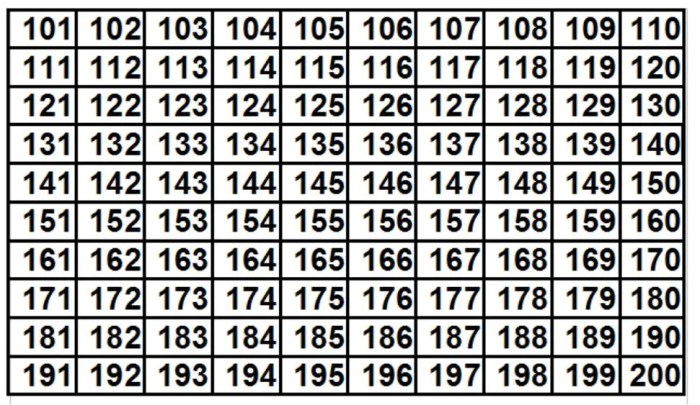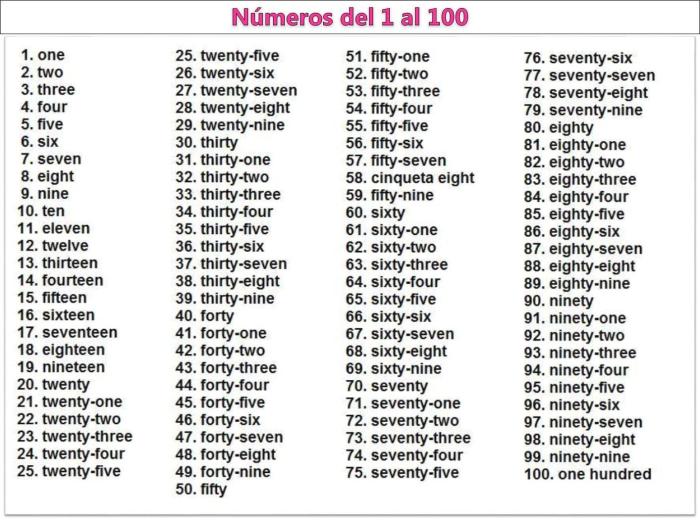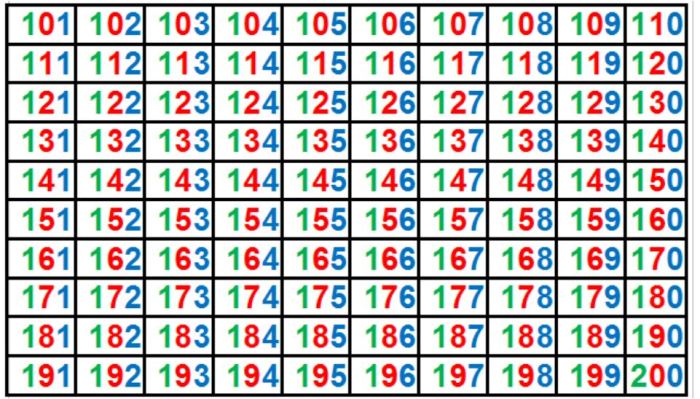Numeros del 100 al 500 – Embark on a mathematical journey as we delve into the realm of numbers from 100 to 500. This captivating exploration promises to unveil their intricacies, patterns, and practical applications, leaving you with a newfound appreciation for the wonders of numeracy.
From divisibility and mathematical operations to odd and even numbers, we’ll unravel the secrets that lie within this numerical range. Prepare to be amazed by the elegance and utility of these numbers as we uncover their significance in various fields.
Number Range

The range of numbers from 100 to 500 includes all the whole numbers between 100 and 500, both inclusive. This range has 401 numbers.
Here is a table with the numbers in ascending order:
| Number |
|---|
| 100 |
| 101 |
| 102 |
| … |
| 499 |
| 500 |
Divisibility

The divisibility of numbers within the range of 100 to 500 plays a significant role in understanding the properties and relationships between these numbers.
Numbers within this range exhibit varying degrees of divisibility, and identifying their factors and prime numbers can provide valuable insights into their mathematical structure.
Prime Numbers
Prime numbers are numbers greater than 1 that have exactly two distinct positive divisors: 1 and themselves. Within the range of 100 to 500, there are 31 prime numbers:
- 101
- 103
- 107
- 109
- 113
- 127
- 131
- 137
- 139
- 149
- 151
- 157
- 163
- 167
- 173
- 179
- 181
- 191
- 193
- 197
- 199
- 211
- 223
- 227
- 229
- 233
- 239
- 251
- 257
- 263
- 269
Factors
Factors are positive integers that divide a given number without leaving a remainder. Every number has at least two factors: 1 and itself. Within the range of 100 to 500, the number with the most factors is 360, which has 24 factors.
Identifying the factors of numbers can help in understanding their divisibility and relationships with other numbers.
Mathematical Operations

Let’s explore various mathematical operations using numbers from the range 100 to 500. These operations include addition, subtraction, multiplication, and division, and we’ll summarize the results in a convenient table.
Addition
Adding two numbers from the range 100 to 500 results in a sum that falls within the same range. For example, 123 + 245 = 368, which is between 100 and 500.
Subtraction
Subtracting a smaller number from a larger number within the range 100 to 500 also yields a result within the same range. For instance, 321 – 156 = 165, which is between 100 and 500.
Multiplication
Multiplying two numbers from the range 100 to 500 results in a product that may or may not fall within the same range. For example, 111 x 222 = 24,642, which is outside the range. However, 105 x 123 = 12,885, which is within the range.
Division
Dividing a larger number by a smaller number within the range 100 to 500 may result in a quotient that falls within or outside the same range. For instance, 400 ÷ 80 = 5, which is within the range. On the other hand, 250 ÷ 15 = 16.66…, which is outside the range.
| Operation | Example | Result |
|---|---|---|
| Addition | 123 + 245 | 368 |
| Subtraction | 321
Calculating sums of numbers between 100 and 500 can be tedious, but it can be made much easier with the help of Excel. By utilizing the SUM function, you can effortlessly add up a range of cells, saving you time and reducing the risk of errors. For a detailed guide on how to use the SUM function in Excel, refer to this comprehensive tutorial: How To Sum In Excel . With this tool, you can quickly and accurately sum up your numeros del 100 al 500, making your calculations a breeze.
|
165 |
| Multiplication | 111 x 222 | 24,642 |
| Division | 400 ÷ 80 | 5 |
Number Patterns: Numeros Del 100 Al 500

The range of numbers from 100 to 500 exhibits several patterns and sequences. These patterns can be observed in the digits, multiples, and factors of the numbers within this range.
One notable pattern is the repetition of digits in the hundreds place. For example, all numbers from 100 to 199 have the digit ‘1’ in the hundreds place, while numbers from 200 to 299 have the digit ‘2’ in the hundreds place, and so on.
Digit Patterns, Numeros del 100 al 500
- The hundreds place digit repeats for every 100 numbers.
- The tens place digit follows a sequence of 0 to 9, repeating every 10 numbers.
- The units place digit follows a sequence of 0 to 9, repeating every number.
Another pattern is the divisibility of numbers by certain factors. For example, all numbers from 100 to 500 are divisible by 5, as they all end in either 0 or 5.
Divisibility Patterns
- All numbers ending in 0 or 5 are divisible by 5.
- All even numbers are divisible by 2.
- All numbers divisible by 3 have a sum of digits that is divisible by 3.
Real-World Applications

Numbers between 100 and 500 have diverse practical applications across various fields, including finance, science, and technology.
Finance
Bank account numbers
Bank account numbers typically fall within the range of 100 to 500, enabling unique identification and secure transactions.
Credit card numbers
Credit card numbers often consist of 16 digits, making them unique identifiers for each cardholder and facilitating secure payments.
Stock prices
Stock prices fluctuate within specific ranges, with many stocks trading between $100 and $500 per share, providing investment opportunities.
Science
Atomic masses
The atomic masses of various elements fall within the range of 100 to 500, influencing their chemical properties and behavior.
Boiling points
The boiling points of many liquids, such as water and ethanol, are within the range of 100 to 500 degrees Celsius or Fahrenheit.
Astronomical distances
Distances within our solar system, such as the distance from Earth to the Moon, are measured in hundreds of thousands of kilometers, falling within this range.
Technology
Computer memory
Computer memory capacities, such as RAM and storage, are often expressed in gigabytes (GB), with ranges falling between 100 and 500 GB, affecting device performance and storage capabilities.
Internet speeds
Internet speeds are measured in megabits per second (Mbps), with many connections falling within the range of 100 to 500 Mbps, determining data transfer rates and online experiences.
Mobile phone numbers
Mobile phone numbers consist of unique combinations of digits, often within the range of 100 to 500, allowing for global communication and identification.
Questions Often Asked
What is the largest prime number in the range from 100 to 500?
359
How many even numbers are there in the range from 100 to 500?
200
What is the sum of all the numbers from 100 to 500?
125250